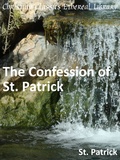St. Patrick
Patron saint of Ireland
Biography
Saint Patrick was born somewhere along the west coast of Britain in the little settlement or village of Bannavem of Taburnia (vico banavem taburniae in his Confession), which has never been securely identified. It was probably on a coast in the south of England, (sites suggested include Dumbarton and Somerset) for raiders captured Patrick with "many thousands of people" and sold them as slaves in Ireland.
His father was Calpornius, a deacon, son of Potitus, a priest in the era before celibacy was ordained for priests, who was a Romanized Briton. A questionable old tradition makes his mother from the upper-class Gaulish family of Martin of Tours, though Patrick makes no such prideful claim. According to his Confession at the age of about sixteen, Patrick was captured and taken to Ireland as a slave to a Druidic chieftan named Milchu in Dalriada, County Antrim (though Fochill in Co. Mayo is the more likely setting).
Although he came from a Christian family he was not particularly religious before his capture. However, his enslavement markedly strengthened his faith. He escaped at the age of twenty-two and returned to Britain, reuniting with his parents and later becoming one of the first Christian clergymen in Ireland, being preceded by men such as Pallidius (c.380-457/61).
His first converted patron was Dichu, who made a gift of a large sabhall (barn) for a church sanctuary. This first sanctuary dedicated by St. Patrick became in later years his chosen retreat. A monastery and church were erected there, and there Patrick died; the site retains the name Sabhall (pronounced "Saul").
The story of the annual vernal fire that was to be lit by the High King at Tara, when all the fires were extinguished, to be renewed from the sacred fire from Tara, and of Patrick's rival, miraculously inextinguishable Christian bonfire on the hill of Slane at the opposite end of the valley, is famous among his many exploits. The season was associated with Easter (compare the British season of Eostre) by the Christian chroniclers who followed Patrick's own account in his Confessio,
He was one of the earliest writers to advocate the abolition of slavery.
Patrick was not the first Christian missionary to Ireland, as men such as Secundus and Pallidius were active in the south of the island long before him. However, tradition accords him the most impact, and his missions do seem to have being concentrated in the provinces of Ulster and Connaught which had never received Christians before.
Mythology credits him with banishing snakes from the island of Ireland, though others suggest that for climatic reasons Ireland never actually had snakes; one suggestion is that "snakes" referred to the serpent symbolism of the Pagan priests of that time and place, the Druids, possibly shown by their tattoos or that it could have referred to Pelagianism, symbolized as an Old-Testamental "serpent".
Legend also credits Patrick with teaching the Irish about the concept of the Trinity by showing people the shamrock, a three-leaved clover, using it to highlight the Christian dogma of 'three divine persons in the one god' (as opposed to the Arian heresy that was popular in Patrick's time).
It is unknown on what date he was born and died but it is believed that March 17 was his death date (according to the Encyclopedia Britannica), and it is the date popularly associated with him as his Feast Day (known as St. Patrick's Day).

